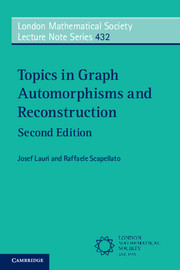Book contents
- Frontmatter
- Dedication
- Contents
- Preface to the Second Edition
- Preface to the First Edition
- 1 Graphs and Groups: Preliminaries
- 2 Various Types of Graph Symmetry
- 3 Cayley Graphs
- 4 Orbital Graphs and Strongly Regular Graphs
- 5 Graphical Regular Representations and Pseudosimilarity
- 6 Products of Graphs
- 7 Special Classes of Vertex-Transitive Graphs and Digraphs
- 8 The Reconstruction Conjectures
- 9 Reconstructing from Subdecks
- 10 Counting Arguments in Vertex-Reconstruction
- 11 Counting Arguments in Edge-Reconstruction
- References
- List of Notations
- Index of Terms and Definitions
Preface to the Second Edition
Published online by Cambridge University Press: 05 June 2016
- Frontmatter
- Dedication
- Contents
- Preface to the Second Edition
- Preface to the First Edition
- 1 Graphs and Groups: Preliminaries
- 2 Various Types of Graph Symmetry
- 3 Cayley Graphs
- 4 Orbital Graphs and Strongly Regular Graphs
- 5 Graphical Regular Representations and Pseudosimilarity
- 6 Products of Graphs
- 7 Special Classes of Vertex-Transitive Graphs and Digraphs
- 8 The Reconstruction Conjectures
- 9 Reconstructing from Subdecks
- 10 Counting Arguments in Vertex-Reconstruction
- 11 Counting Arguments in Edge-Reconstruction
- References
- List of Notations
- Index of Terms and Definitions
Summary
In this second edition of our book we have tried to maintain the same structure as the first edition, namely a text which, although not providing an exhaustive coverage of graph symmetries and reconstruction, provides a detailed coverage of some particular areas (generally motivated by our own research interest), which is not a haphazard collection of results but which presents a clear pathway through this thick forest. And our aim remains that of producing a text which can relatively quickly guide the reader to the point of being able to understand and carry out research in the topics which we cover.
Among the additions in this edition we point out the use of the free computer programs GAP, GRAPE and Sage to construct and investigate some wellknown graphs, including examples with properties like being semisymmetric, a topic which was treated in the first edition but for which examples are not easy to construct ‘by hand’. We have also updated some chapters with new results, improved the presentation and proofs of others, and introduced short treatments of topics such as character theory of abelian groups and their Cayley graphs to emphasise the connection between graph theory and other areas of mathematics.
We have corrected a number of errors which we found in the first edition, and for this we would like to thank colleagues who have pointed out several of them, particularly Bill Kocay, Virgilio Pannone and Alex Scott.
A special thanks goes to Russell Mizzi for help with overhauling Chapter 6, where we also introduce the new idea of two-fold isomorphisms, and to Leonard Soicher and Matan Zif-Av for several helpful tips regarding the use of GAP and GRAPE.
The second author would like to thank the Politecnico di Milano for giving him the opportunity, by means of a sabbatical, to focus on the work needed to complete the current edition of this book. He also thanks the University of Malta for its kind hospitality during this sabbatical. The authors will maintain a list of corrections and addenda at http://staff.um.edu.mt/josef.lauri.
- Type
- Chapter
- Information
- Topics in Graph Automorphisms and Reconstruction , pp. xi - xiiPublisher: Cambridge University PressPrint publication year: 2016



